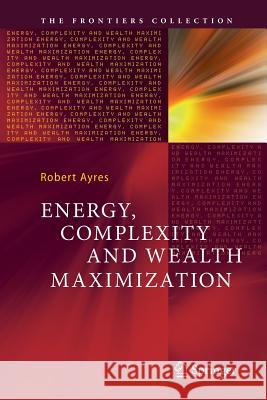Energy, Complexity and Wealth Maximization » książka



Energy, Complexity and Wealth Maximization
ISBN-13: 9783319808352 / Angielski / Miękka / 2018 / 593 str.
Energy, Complexity and Wealth Maximization
ISBN-13: 9783319808352 / Angielski / Miękka / 2018 / 593 str.
(netto: 345,02 VAT: 5%)
Najniższa cena z 30 dni: 346,96
ok. 22 dni roboczych
Bez gwarancji dostawy przed świętami
Darmowa dostawa!
Wydanie ilustrowane
"Ayres does a great job in 'explaining energy or entropy to otherwise educated people' ... which was the starting point of this book. He not only illustrates the physical basics of thermodynamics in a very comprehensible way for non-physicists, but also points out the importance of energy for the evolution of mankind. Therefore, (energy) economists as well as people interested in the interdependency between physics, technology and economics will certainly enjoy reading this book." (Daniel Nachtigall, Journal of Economics, Vol. 121, 2017)
Preface.- Glossary of terms.- Glossary of people.- PART I.- CHAPTER 1. A BRIEF HISTORY OF IDEAS: ENERGY, ENTROPY AND EVOLUTION.- 1.1. Aristotle, Descartes, Newton and Leibnitz.- 1.2. Heat: caloric vs phlogiston.- 1.3. The birth of thermodynamics and statistical mechanics.- 1.4. Chemistry: from Lavoisier to Gibbs.- 1.5. Electricity and electromagnetism.- 1.6. Geology and Earth science.- 1.7. Darwin and biological evolution.- 1.8. Ecology.- 1.9. Entropy, exergy, order and information.- 1.10. Monism, “energetics” and economics.- CHAPTER 2. THE COSMOS, THE SUN AND THE EARTH.- 2.1. Relativity, quantum mechanics and astronomy.- 2.2 The black hole in physics.- 2.3 Nucleosynthesis: Love among the nucleons.- 2.4. The Sun and solar system.- 2.5. The elements needed to sustain life (and technology).- 2.6. The terra-forming of Earth.- 2.7. The long-term future of Planet Earth.- 2.8 Summary of pre-biotic evolution.- CHAPTER 3. THE ORIGIN OF LIFE.- 3.1. Exogenesis?.- 3.2. The origin of organic monomers.- 3.3. From monomers to polymers.- 3.4. Self-replication of macromolecules (genes).- 3.5. Genetic code: RNA and DNA.- 3.6. Information transfer: the genetic code.- 3.7. Oxygen photosynthesis.- 3.8. The “Great Oxidation” and the “invention” of respiration.- 3.9. Evolution before the Cambrian explosion.- 3.10. The “Cambrian explosion”.- 3.11. Since the asteroid.- 3.12 Down from the trees.- CHAPTER 4. ENERGY, WATER, CLIMATE AND CYCLES.- 4.1. The Earth’s energy (exergy) balance.- 4.2. The hydrological cycle.- 4.3. Ocean currents and atmospheric circulation.- 4.4. Climate change.- 4.5. Bio-geochemical cycles.- 4.6. The carbon-oxygen cycle.- 4.7. The nitrogen cycle.- 4.8. The sulfur cycle.- 4.9. The phosphorus cycle.- 4.10. Thermodynamic dis-equilibrium.- Summary of Part I: From the “Big Bang” to nutrient cycles.- PART II.- CHAPTER 5. ENERGY AND TECHNOLOGY.- 5.1. The enhancement of skin.- 5.2. The taming of fire.- 5.3.Transmission of knowledge: writing and replication.- 5.4. The dawn of civilization and the beginning of agriculture.- 5.5. Agricultural surplus and cities.- 5.6. Slavery and conquest.- 5.7. Money and coinage.- 5.8. Productive technology.- CHAPTER 6. THE NEW WORLD – AND SCIENCE.- 6.1. The discovery of the New World.- 6.2. From charcoal and iron to coal and steel.- 6.3. Gunpowder and cannons.- 6.4. Steam power.- 6.5. Town gas, coal tar, aniline dyes and ammonia synthesis.- 6.6. Petroleum.- 6.7. The internal (infernal) combustion engine.- 6.8. Electrification and communications.- 6.9 Telecommunication and digital technology.- 6.9. The demographic transition: the final disproof of Malthus or a prelude?.- CHAPTER 7. ENERGY, TECHNOLOGY AND THE FUTURE.- 7.1. This time is different.- 7.2. “Peak Oil”.- 7.3. More on fracking: Is it a game changer?.- 7.4. The inevitable decline of the internal combustion engine.- 7.5 On opportunities for energy efficiency gains by systems integration..- 7.6. Renewables for heat and electric power generation.- PART III.- CHAPTER 8. MAINSTREAM ECONOMICS AND ENERGY.- 8.1. Core ideas in economic theory.- 8.2 On credit, collateral, virtual money and banking.- 8.3 On externalities.- 8.4. Economics as social science.- 8.5. Resources and economics.- 8.6.Resource discoveries as technology incubators.- 8.7. On the geology of resources: scarcity again?.- 8.8. The special case of petroleum.- 8.9. The role of resources in standard economic theory.- CHAPTER 9. NEW PERSPECTIVES ON CAPITAL, WORK, AND WEALTH.- 9.1. Active vs passive capital.- 9.2. Exergy, useful work and production functions.- 9.3. Wealth as “condensed” work and useful complexity.- 9.4. Debt: The downside of financial wealth creation.- 9.5. The direct costs of economic growth.- 9.6. More on economic growth: cycles and bubbles.- 9.7. Planetary limits: The downside of material wealth creation.- 9.8. The “circular economy” and the limits to growth.- 9.9. A Trifecta?.- Epilogue.- APPENDIX. ENERGY IN GROWTH THEORY.- A.1. Introduction.- A.2. Growth equations.- A.3. A new variable: Useful work U.- A.4. The choice of production function.- A.5. Statistical analysis of the time series.- A.6. Results.- A.7. Conclusion.- References.
1997-2025 DolnySlask.com Agencja Internetowa
KrainaKsiazek.PL - Księgarnia Internetowa









